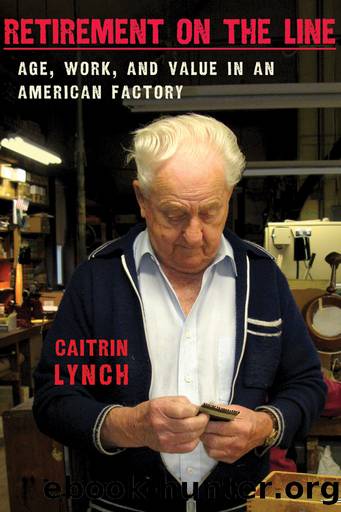Retirement on the Line by Caitrin Lynch

Author:Caitrin Lynch [Lynch, Caitrin]
Language: eng
Format: epub
Tags: Social Science, Anthropology, Cultural & Social, Political Science, Labor & Industrial Relations, History, United States, State & Local, New England (CT; MA; ME; NH; RI; VT)
ISBN: 9780801464560
Google: kbYEG3Gr0CwC
Publisher: Cornell University Press
Published: 2012-03-08T05:27:48+00:00
Conclusion: Corporate Loyalty and a Way of Life
Vita workers consider Vita a sanctuary, an oasis; they experience it as a place that is comforting and caring, where they can belong. As Grantâs evocation of antique people and antique machinery suggests, for some it is a world reminiscent of the pastâand many workers value it for its familiarity. In her study of Walmart, historian Bethany Moreton describes the ways in which the Ozarks occupy a place in the imagination of many Americans as an âimagined homogeneous yesterday; Americaâs yesterday.â21 Walmart, today one of the worldâs largest and most profitable companies, strategically crafts a corporate history that appeals to a sense of place and identity of its workers in its nostalgic origins in the Ozarks, Americaâs heartland.
There is a long history of companies immersing themselves in their local contexts to better conduct their operations, and the history of manufacturing in the United States famously involves dynamics of family and factory, where factories connect to the community through family connections and through playing a family-like role in communities. We have already seen how Vita Needleâs workers have deep and varied ties to each other outside work. A second German magazine article explains that building on community connections is a managerial strategy. After noting that Mike hires only locals because âthis makes the new beginning easier for everyone,â journalist Stefanie Hellge continues:
But there is another reason. As a rule, there are already medical records in the local hospital for the people from the area, in the event that something really does happen, in case someone falls or becomes ill. La Rosa, who is 50, ensures that each is up to the task he or she is assigned, and he has long since become something of a social worker. If someone doesnât show up for work, he will telephone. If no one answers, he will drive to the employeeâs home and knock on the door until someone answers. âWe have a social responsibility for these people,â La Rosa says, âand we pay attention to that.â That also means having to accept that his employees become slower as they age or having to overlook someone falling asleep on the job, such as Marion, 96, who nodded off on her stool at the end of each day until her children forbid her to keep working at Vita Needle. Her last day was a Friday. On Sunday she was dead.22
Here we see several motives behind the managerial policy of hiring locals, which we already know contributes to the workersâ sense of sameness and belonging. On the social end, Mike wants people to âfit inâ (a term he has used in discussions with me), which they will if they already have connections to each other. But on the more logistical end, he wants workers who are already registered at the local hospital and who live nearby so he can check in on them (like a social worker) if they do not show up to work.
A team of researchers has
Download
This site does not store any files on its server. We only index and link to content provided by other sites. Please contact the content providers to delete copyright contents if any and email us, we'll remove relevant links or contents immediately.
Cecilia; Or, Memoirs of an Heiress — Volume 1 by Fanny Burney(32438)
Cecilia; Or, Memoirs of an Heiress — Volume 2 by Fanny Burney(31875)
Cecilia; Or, Memoirs of an Heiress — Volume 3 by Fanny Burney(31858)
The Great Music City by Andrea Baker(31516)
We're Going to Need More Wine by Gabrielle Union(18972)
All the Missing Girls by Megan Miranda(15590)
Pimp by Iceberg Slim(14398)
Bombshells: Glamour Girls of a Lifetime by Sullivan Steve(13978)
Talking to Strangers by Malcolm Gladwell(13232)
Norse Mythology by Gaiman Neil(13211)
Fifty Shades Freed by E L James(13162)
For the Love of Europe by Rick Steves(13094)
Mindhunter: Inside the FBI's Elite Serial Crime Unit by John E. Douglas & Mark Olshaker(9206)
Crazy Rich Asians by Kevin Kwan(9171)
The Lost Art of Listening by Michael P. Nichols(7411)
Enlightenment Now: The Case for Reason, Science, Humanism, and Progress by Steven Pinker(7240)
The Four Agreements by Don Miguel Ruiz(6637)
Bad Blood by John Carreyrou(6558)
Weapons of Math Destruction by Cathy O'Neil(6149)
